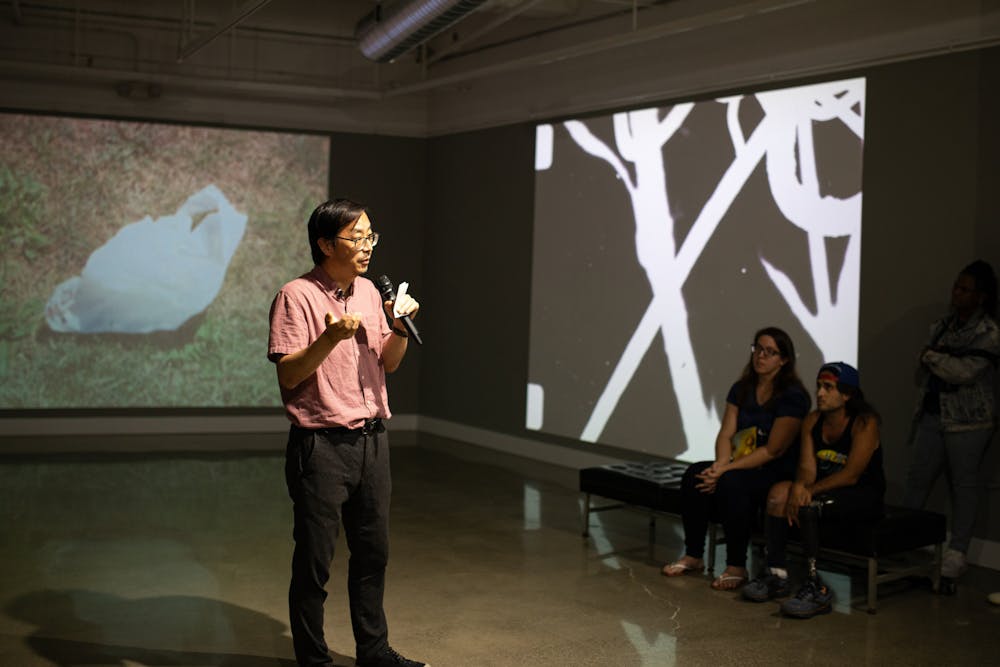Surveying an area you have walked in for nearly 10 years may seem monotonous to the average eye, yet for media artist Carl Lee, new discoveries are never a rarity. Since 2014, the daily walk Lee has taken with his dog on Unity Island has lent him an intimate perspective of the quarter-square-mile strip between the Niagara River and Black Rock Canal.
Lee has seen a colony of beavers suddenly appear and become a part of the existing ecology that include snakes, foxes and birds. He’s also observed how the area serves as a community space for the local Karen refugees every weekend, who host big picnics with barbecue and Sepak Takraw (kick volleyball) tournaments. The community’s presence made Lee reminisce on the times he and his family hosted barbecues with other Korean families at his local park.
It is the personal, social, and environmental lore that Lee has gathered that take shape in his new 16mm film installation, “Unity Island” on display at Buffalo Arts Studio.
Lee is the director of equipment and facilities in UB’s Department of Media Studies where he also teaches a class on shooting 16mm film — a medium he’s returned to consistently in the past few years. Lee is the recipient of the 2023 NYSCA Support for Artists grant. His practice uses optical tricks to probe the “distance and intimacy and the precarity of images on our screens and in our heads” and “[represent] not simply memory in space, but the act of remembering and perceiving.”
In a previous project, “Fire Escape,” Lee studied his neighbor’s fire escape, outside his office window. The project was birthed from examining the course of light throughout the day that generated interesting patterns and shadows.
Unlike Lee’s past installations, there is no optical mechanism mediating the viewing experience for “Unity Island.”
“Unity Island” is composed of three screen projections, and offers a series of perspectives of the island for visitors to consider the notion that “close observation of the mundane can often reveal something profound” — a practice that is integral to Lee’s observational nature.
A shot on the left projection captures the simple motion of a swing bridge rotating, a motion that urges further inspection for Lee.
“Why is a swing bridge rotating amazing, to me, at least and to other people? One of the things is that something so permanent-looking suddenly changes,” Lee said. “Your impression of it was that it’s massive and immutable but then it changes and there’s a little bit of surprise to seeing it.”
The center projection introduces us to Lee’s dog, Augie, leading the viewer through the island. The scene cuts to Augie springing into the water and paddling with a long stick and a seemingly novel excitement, despite how familiar this activity may be. Lee lingers on this feeling by transposing two more layers of Augie over the original one. Like other dogs navigating waters, part of the charm of Augie’s paddling is from the human curiosity of what it’s like to swim as a four-legged animal.
The concluding sequence in the center projection pays homage to Rose Lowder’s series called “Bouquets.”
“They’re basically shots of flowers intercut with other natural images,” Lee said of Lowder’s work. “But they’re frame by frame cuts. So she takes a shot of one thing, takes another shot [of another thing]. Just a frame and it flickers [between the frames].”
Lee translates Lowder’s influence by punctuating frames of flowers with images of trash ranging from a crinkled Poland Spring bottle and an aggressively squashed Kool-Aid drink to a glue bottle and a plastic bag.
The installation also features shots of Augie with Lee’s wife, Dorothea, walking through grassy knolls. One critical shot shows Dorothea and Augie standing atop a hill with a triumphant attitude as Lee films them from their point of descent. Another shot features a worker exiting from a tower seemingly checking for the presence of something on their left and right, an act that we may engage in daily without considering the beauty of its universality.
“Unity Island,” provides visitors the opportunity to engross themselves in vantage points of the island that deserve an inquisitive eye. The installation is on view now until Nov. 3 at Buffalo Arts Studio. The studio is open from Tuesday to Friday at 11 a.m. to 5 p.m. and Saturdays from 10 a.m. to 2 p.m.
Tenzin Wodhean is an arts editor and can be reached at tenzin.wodhean@ubspectrum.com





